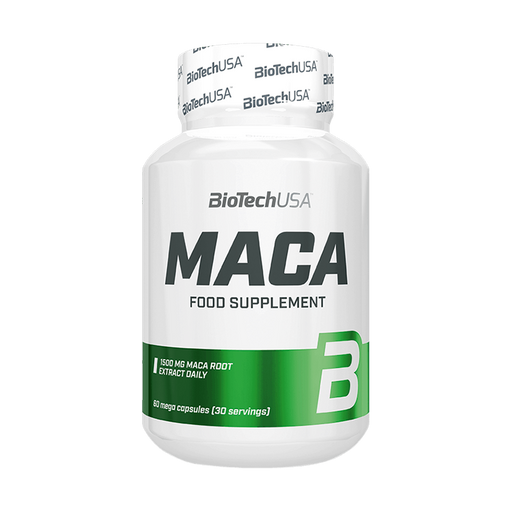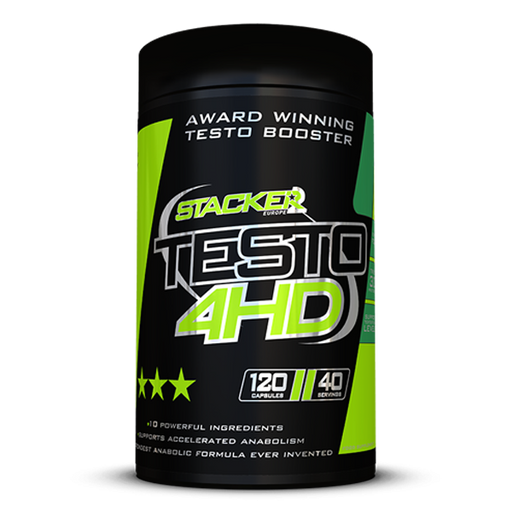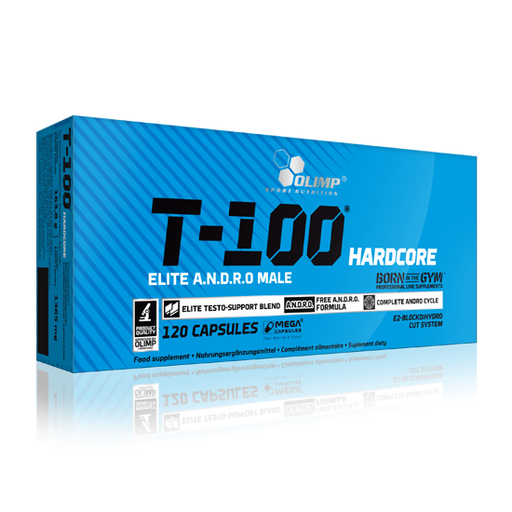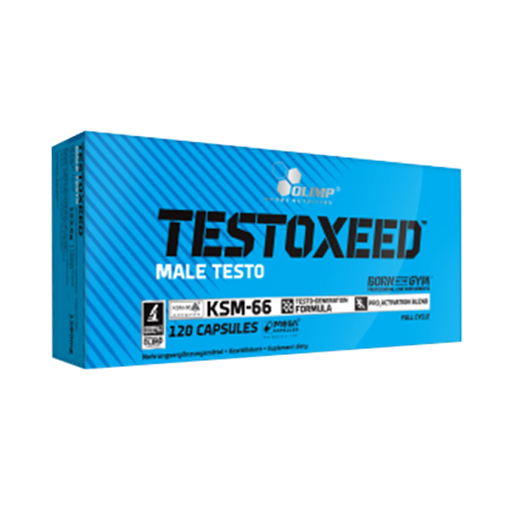Maca
-
 Save 11%
Save %
Original price €39,90Original price €39,90 - Original price €39,90Original price €39,90Current price €35,51€35,51 - €35,51Current price €35,51| /
Save 11%
Save %
Original price €39,90Original price €39,90 - Original price €39,90Original price €39,90Current price €35,51€35,51 - €35,51Current price €35,51| /Genetic Test Ultimate · 180 capsules
GN Laboratories30 reviewsGN Laboratories Genetic Test is probably the most extreme and effective legal hormone booster you will find on the market! Testo Booster of the Yea...
View full detailsOriginal price €39,90Original price €39,90 - Original price €39,90Original price €39,90Current price €35,51€35,51 - €35,51Current price €35,51| /Save 11% Save % -
 Save 0%
Save %
Original price €15,90 - Original price €15,90Original price €15,90€15,90€15,90 - €15,90Current price €15,90| /
Save 0%
Save %
Original price €15,90 - Original price €15,90Original price €15,90€15,90€15,90 - €15,90Current price €15,90| /Maca · 60 capsules
Biotech USA2 reviewsMaca is a wild-growing, tuber-forming plant from Peru Maca contains phytonutrients, amino acids and fatty acids Maca is also known as Peruvian gin...
View full detailsOriginal price €15,90 - Original price €15,90Original price €15,90€15,90€15,90 - €15,90Current price €15,90| /Save 0% Save % -
 Save 0%
Save %
Original price €34,90 - Original price €34,90Original price €34,90€34,90€34,90 - €34,90Current price €34,90| /
Save 0%
Save %
Original price €34,90 - Original price €34,90Original price €34,90€34,90€34,90 - €34,90Current price €34,90| /Testo 4HD · 120 capsules
Stacker 24 reviewsTESTO-4HD promotes the production of muscle-building hormones up to the natural limit TESTO-4HD offers more training bite and higher training inte...
View full detailsOriginal price €34,90 - Original price €34,90Original price €34,90€34,90€34,90 - €34,90Current price €34,90| /Save 0% Save % -
 Save 0%
Save %
Original price €34,90 - Original price €34,90Original price €34,90€34,90€34,90 - €34,90Current price €34,90| /
Save 0%
Save %
Original price €34,90 - Original price €34,90Original price €34,90€34,90€34,90 - €34,90Current price €34,90| /T-100 Hardcore · 120 capsules
Olimp Sport Nutrition2 reviewsT-100® HARDCORE is a dietary supplement in capsules. It has an optimized and even stronger composition than the previous appearance. The formula c...
View full detailsOriginal price €34,90 - Original price €34,90Original price €34,90€34,90€34,90 - €34,90Current price €34,90| /Save 0% Save % -
 Save 0%
Save %
Original price €33,90 - Original price €33,90Original price €33,90€33,90€33,90 - €33,90Current price €33,90| /
Save 0%
Save %
Original price €33,90 - Original price €33,90Original price €33,90€33,90€33,90 - €33,90Current price €33,90| /Testoxeed · 120 capsules
Olimp Sport Nutrition1 reviewTestoxeed is a hormone booster to maximize muscular performance Contains high-quality ingredients to support the production of muscle-building hor...
View full detailsOriginal price €33,90 - Original price €33,90Original price €33,90€33,90€33,90 - €33,90Current price €33,90| /Save 0% Save % -
 Sold out
Original price €29,90 - Original price €29,90Original price €29,90€29,90€29,90 - €29,90Current price €29,90| /
Sold out
Original price €29,90 - Original price €29,90Original price €29,90€29,90€29,90 - €29,90Current price €29,90| /Fortest · 120 capsules
Olimp Sport Nutrition1 reviewPioneering composition of high-quality components A formula developed for men over 35 years of age Support for potency and sexual function (maca r...
View full detailsOriginal price €29,90 - Original price €29,90Original price €29,90€29,90€29,90 - €29,90Current price €29,90| /Sold out
Lepidium meyenii, known as maca, is a radish-like tuber from the highlands of the Andes. It is said that the plant was already used for nutritional and medicinal purposes in Inca times. Maca is extremely nutritious, rich in sugar, protein, starch and essential minerals. The maca tuber is eaten baked or boiled and crushed or fermented to make a drink: Maca chicha. Maca preparations are already a sales hit in the USA and South America.
Maca - a resilient plant
Maca, botanically known as "Lepidium Meyenii Walp", originates from South America. It grows in the high plateaus of the Peruvian Andes, where it is exposed to extreme climatic conditions: Temperatures range between four and seven degrees and a strong wind blows continuously. The UV radiation is intense and the soil is very acidic. The plant's resilience is enormous. It is still grown ethically by small farmers on unused land and processed traditionally. Maca is one of the oldest Peruvian folk remedies. It is said there that the root makes you "strong for life and strong for love". The plant grows to a height of around 20 centimetres and has a main root and many secondary tuberous roots. The green part of the plant that grows above ground is prepared as a vegetable by the Peruvians. Some of the roots are also used fresh in the Andes: they are washed, cooked and eaten. The rest of the harvest is dried and cooked before consumption. Maca root can also be processed into flour. The whole, pear-shaped roots are mainly used as a tonic for the whole body and for rituals associated with masculinity and fertility.
Ingredients
The maca root contains many valuable proteins, lots of iron, zinc, magnesium, calcium, carbohydrates, phosphorus, sugar, starch, important minerals, almost all vitamins and also hormone-like substances. The latter ensure better blood circulation in the pelvis and at the same time stimulate the production of testosterone in men and oestrogen in women. The plant also contains around 300 other substances, such as colorants and essential oils, some of which have not yet been studied in detail. The effect on the libido in men is probably explained by the specific composition of these ingredients.
Studies from the USA, Argentina and Canada have led to the following results:
- Help with childlessness
- Regular consumption can help to reduce stress and the consequences of stress.
- Maca can be used to combat chronic fatigue.
- Maca helps to build up missing energy in the body.
- Maca can help to increase performance, for example in competitive sports.
- Sexual listlessness can be reduced.
- Maca is helpful for erectile dysfunction.
- It promotes fertility in women.
- People with bad moods and depression feel better.
- Maca regulates menstrual problems and irregularities.
- Maca can alleviate typical menopausal problems.
The analysis of maca root revealed the following values, among others
Nutritional value analysis (1):
- Protein 11.6%
- fat 0.9%
- Water content 10.1%
- Ash 4.7%
- Carbohydrates 52.0%
- Dietary fiber 21.2%
- Nutritional value 270 kcal / 100g / 1130kJoule / 100g
- Vitamin C: 133% of the daily requirement
- Copper: 85% of the daily requirement
- Iron: 23% of the daily requirement
- Potassium: 16% of the daily requirement
- Vitamin B6: 15% of the daily requirement
- Manganese: 10% of the daily requirement
Fatty acids:
- Monounsaturated (c/s) Omega 9 c: Oleic acid 13.4%
- Polyunsaturated (c/s) total 52.8%
- Omega 6 c: Linoleic acid 40%
- Omega 3 c: alpha linolenic acid 12.8%
- Total saturated 33.8%
- Palmitic acid 25.4%
- Stearic acid 3.8%
- Henicosanoic acid 3.8%
- Behenic acid 1.4%
- Lignorceric acid 1.2%
Sugar:
- Fructose 5.9%
- Glucose 5.2%
- Sucrose 16.6%
- Maltose <0.1%
- Lactose 2.1%
Active ingredients
Maca is rich in calcium, potassium, iron and iodine. The root also contains copper, manganese, zinc, vitamin C, riboflavin (vitamin B2) and thiamine (vitamin B2) (2). In addition, maca contains 20 different fatty acids and 19 amino acids.
Red and black maca contain high levels of choline and red maca is rich in GABA (2). The primary active compound in maca is the alkaloid macaridin, which has not yet been found in any other plant (3). Maca also contains macamides - fatty acids found only in maca.
Glucosinolates are other active compounds in maca that contribute to the bitter taste. Fresh maca contains ten times more glucosinolates than other cruciferous vegetables. Red maca contains the highest amount of glucosinolates, followed by black and yellow maca (4, 5). Maca also contains polyphenols, the content and composition of which can vary depending on the color of the root (6). In addition, maca contains a compound called MCTA, which inhibits the monoamine oxidase enzyme (an enzyme that breaks down certain neurotransmitters) and has been shown in cell studies to have the ability to induce DNA mutations (7).
Mechanisms of action of maca
- Maca contains macamides, which are fatty acids that influence the endocannabinoid system (8).
- Macamides increase anandamide levels by blocking the fatty acid amide hydrolase (FAAH), an enzyme that synthesizes anandamide (9).
- Anandamide acts at the cannabinoid CB1 receptor to induce a feeling of happiness.
- Black maca reduces hemoglobin levels in people living at high altitude (2).
- Elevated hemoglobin levels at high altitude are associated with chronic altitude sickness (10).
- Maca neutralizes free radicals and protects against oxidative stress (11, 12).
- Maca increased white blood cell levels in fish (13).
- Maca increases IGF-1 levels in human articular cartilage, which may be responsible for the positive effects of maca on bone health (12).
- Maca reduces the activity of angiotensin-converting enzyme (ACE), which reduces the availability of angiotensin - a hormone that increases blood pressure (14).
Health benefits of maca
Maca may improve sexual function and sex drive
Chemical analysis reveals the presence of biologically active aromatic isothiocyanates, specifically p-methoxybenzyl isothiocyanates, which are known to have aphrodisiac properties. Further analysis reveals glucosinolates, which may explain the fertility-enhancing effects. In April 2000, the journal "Urology" published the work of Chinese researchers Zheng et al. who measured the effect of maca on the sexual behavior of mice. The result of this study was striking: the mice fed with Maca were about 3 times as "active" sexually as the comparison mice fed on a normal diet. In addition, mice with erectile dysfunction - yes, it's hard to believe that this also exists in mice - showed a significant improvement in their symptoms. The researchers conclude: "The present study shows for the first time an aphrodisiac activity of L. meyenii (Maca), a mountain plant of the Andes. The Peruvian scientist Gustavo Gonzales gave twelve men between 20 and 40 years of age maca for three months and then examined their fertility. After just two weeks, he found that the average sperm count doubled. At the same time, more male hormones were produced and the test subjects claimed that their sexual desire had increased significantly. The neurologist Fernando Cabieses, who also investigated the potency-enhancing effect of maca, found that the plant not only increases erectile function, but also the general drive to engage in sexual activity in the long term - without any known side effects. In a study of 57 healthy men, taking maca for 12 weeks increased their sexual desire (15). In another study with 8 men, taking Maca for 2 weeks also increased their sex drive (17). In another study with 20 men and women, taking Maca for 12 weeks alleviated sexual dysfunction induced by antidepressants and also increased sex drive. These effects were strongest with a dose of 3 grams of maca (16). In a study of 50 men suffering from mild erectile dysfunction, taking a Maca extract for 12 weeks improved erectile function and general well-being (18). In a study of 14 healthy postmenopausal women, supplementation with Maca for 6 weeks reduced sexual dysfunction (19). However, these studies are not large enough to say with certainty that maca can increase sex drive or improve sexual function, but they are very promising.
Maca could improve fertility in men
When it comes to male fertility, sperm quality is very important. There is some evidence that maca root can increase male fertility (20, 21). A recent study review summarized the results of five small studies and concluded that maca improved semen quality in both infertile and healthy men (22). One of the studies included nine healthy men as subjects. After consuming Maca for four months, the scientists observed an increase in the volume, number and motility of sperm (21). In another study, black maca also increased the number, volume and quality of sperm in healthy men (23).
Maca could help with anxiety and depression
In rats, maca reduced depressive behavior patterns (24). In small studies involving a total of 43 postmenopausal women, taking maca for six weeks reduced symptoms of anxiety disorders and depression (19, 25). In a study of 197 subjects, 12 weeks of Maca supplementation improved mood, reduced fatigue and increased perceived quality of life (1).
These results are promising, but need to be replicated in larger studies before definitive conclusions can be made about the effects of maca in these areas.
Maca could lower blood pressure
Maca consumption was associated with low blood pressure in an observational study of 50 subjects (26). In a study of 29 postmenopausal women, six weeks of maca supplementation lowered blood pressure (25). However, more large-scale clinical studies are needed to draw definitive conclusions about the effect of maca on blood pressure.
Maca could promote bone health
Reparagen, a compound consisting of 83% Maca, reduced pain and stiffness and improved physical function in a study of 95 osteoarthritis patients (27). In a pilot study of 12 menopausal women, Maca increased bone density over the course of 4 weeks (28). In rats, Maca has been shown to prevent bone loss due to reduced estrogen levels (29, 30).
Maca could reduce symptoms of menopause
Menopause is defined as the period in a woman's life when her menstrual period ends forever. The natural drop in estrogen levels that occurs during this time can cause a number of unpleasant symptoms, which can include hot flashes, vaginal dryness, mood swings, sleep problems and irritability. In a study of 124 postmenopausal women, maca was found to reduce symptoms of menopause (irritability and discomfort due to hot flashes and night sweats) (31).
In a study of 20 postmenopausal women, taking Maca over a period of 2 months reduced the levels of follicle-stimulating hormone and luteinizing hormone, while at the same time increasing oestrogen and progesterone levels (32).
In addition, animal studies suggest that maca may help protect bone health, which is important as postmenopausal women are at higher risk of osteoporosis (29, 30, 33).
Maca could reduce inflammation and oxidative stress
Black maca reduced oxidative stress markers in mice (34). In a study of 50 subjects, it was observed that those who regularly consumed maca had lower levels of inflammatory markers (IL-6) than those who did not consume maca. However, further, larger-scale human studies are needed to determine the effects of maca on inflammation (26).
Maca could lower blood sugar levels
Maca lowered blood glucose levels in a study of 197 adults. These are promising initial results, but require further human studies (1).
Maca could increase athletic performance and energy levels
Maca root is a popular supplement among athletes and bodybuilders. It has been claimed that maca can help build muscle mass and strength, increase energy and improve exercise performance. In addition, some research conducted with animals suggests that maca can increase endurance performance (36, 37, 38). A small study of eight male cyclists found that supplementing with a maca extract for 14 days reduced the time it took these athletes to complete a 40 km race (38). There is currently no scientific evidence to confirm any benefits in terms of strength or muscle mass.
Maca could help against chronic altitude sickness
Chronic altitude sickness is defined as a lack of adaptation to high altitude (10). Maca consumption was associated with a lower incidence of chronic altitude sickness in a study of adult subjects (39). In another study of 50 adults living at high altitude, maca consumption was associated with a higher health-related quality of life (26). In addition, red maca reduced symptoms of chronic altitude sickness in a study of 197 adults (1).
Maca could improve learning ability and memory
Maca could improve brain function (40). In Peru, maca is traditionally used by locals to improve their children's performance at school (41, 42). In animal studies, maca has been shown to improve learning ability and memory in rodents with impaired memory (43, 44, 45, 46). In this respect, black Maca appears to be more effective than other variants (45).
Maca could reduce the size of the prostate
The prostate is a gland that is only present in men. Enlargement of the prostate is also known as benign prostatic hyperplasia, and is common in older people (47). An enlarged prostate can cause problems with urination as the prostate surrounds the urethra. Interestingly, some studies conducted with rodents suggest that red maca can reduce the size of the prostate (48, 49, 50, 51). The effects of red maca on the prostate are thought to be related to its high content of glucosinolates. These substances are also associated with a reduced risk of prostate cancer (52).
Applied to the skin, maca can help protect the skin from the sun
Ultraviolet radiation from the sun can burn and damage unprotected sun-exposed skin. Over time, UV rays cause wrinkles and increase the risk of skin cancer (53). There is evidence that maca extract applied to the skin may help protect the skin from UV rays (41, 64). One study found that maca extract applied to the skin of rats for three weeks prevented skin damage caused by UV radiation (55). The protective effect was attributed to polyphenol antioxidants and glucosinolates, which are found in maca (56). However, it should be borne in mind that a maca extract cannot replace conventional sun protection. Furthermore, maca only protects the skin when it is applied to the skin. Maca has no skin-protecting effect when taken orally.
Need in sport
MACA is a powerful natural extract with an anabolic effect. Maca provides your glands with the raw materials for better hormone production. As this process is completely natural, Maca is not considered doping.
Increased testosterone production
And particularly pleasing for ambitious strength athletes: the body reacts to the intake of the substance with increased testosterone production. This effect is particularly relevant for athletes who want to build muscle, as the natural production of this hormone, which is essential for muscle building, decreases with prolonged exertion. For this reason, Maca is praised by many bodybuilders and especially by the food supplement industry as a natural alternative to harmful doping agents. Various manufacturers state that, as a result of specially commissioned test series, clearly measurable successes have been achieved in over 90% of all athletes. There do not yet appear to be any independent medical studies on the effectiveness of the Andean tuber as a muscle-building supplement.
Increased blood circulation
Maca is also said to significantly improve blood circulation - and even lower blood pressure at the same time. Oxygen and nutrients are better transported to the muscles. The pump effect, in turn, is said to increase training performance and muscle growth. Maca is a food and is not consumed in small quantities. Many capsules contain 500mg of dried maca powder. At this level, many recommend taking three to six capsules per day. One thing to remember is that maca is not a drug and could be supplemented on an ongoing basis. Using it for a short period of time will not give you the best results. My recommendation is a dose of at least six to ten 500 mg capsules per day. That equates to 3,000 to 5,000 mg per day. The longer you take Maca or Maca extract, the more effect you will have. But be careful, too much of a good thing is not good either. Studies have shown that there are no known toxicity or side effects of Maca. Animal studies showed that the longer they took Maca, the more sexually active they became. Maca is an alternative to anabolic steroids that can dramatically increase your sexual function without any dangers or side effects.
Safety and side effects
Maca is probably safe and harmless for most people when taken in the amounts found in food. Maca is potentially safe and harmless when taken in larger amounts as a medicine (up to 3 grams per day) for up to four months. Maca appears to be well tolerated by most people.
Possible side effects of maca
Residents of the Andes in Peru eat up to 100 grams of maca per day with no side effects (57). However, locals recommend eating only dried or cooked maca root, as raw maca root can cause health problems (58). In clinical studies, maca was well tolerated up to doses of 3 grams per day (59). However, in an isolated study of 95 patients suffering from metabolic syndrome, 0.6 grams of maca per day over a 90-day period increased markers of liver damage (aspartate aminotransferase) and diastolic blood pressure (59). In addition, maca contains a compound called MTCA, which can lead to mutations in DNA (7). Because of this danger, some health authorities warn against maca. However, this danger is disputed by scientists who say that MTCA is deactivated when it is cooked (60). Side effects reported by Maca users include an altered menstrual cycle, stomach cramps, moodiness and insomnia (61).
Sources and dosages
Maca can be supplemented as a powder, capsules, flour, liquid extract or extract in powder form. The most common form of Maca is in the form of powder or capsules containing Maca powder. Maca powder is available in two different forms: dehydrated Maca powder (which is often sold as "dried" or "raw Maca") or gelatinized Maca powder. While white maca is the most common type of maca, darker types such as red and black maca may have different biological properties (62, 63). Raw maca powder retains most of the nutrients contained in the maca root, but can be difficult to digest due to its high fiber content. Gelatinized maca powder is cooked and pressed to remove the fiber and make the powder easier to digest. However, some nutrients may be lost during this process. In most studies, the standard dosage of Maca was 1.5 to 3 grams of dehydrated or gelatinized Maca powder taken as a capsule. Maca root powder has an earthy or nutty flavor. Red maca is the sweetest and mildest variety. Yellow maca is the most bitter and black maca is somewhere in between.
Interactions with medications
There are no reports of maca interacting with medications (64).
Precautions and warnings
Pregnancy and lactation: Not enough is known about the safety of maca during pregnancy and lactation. For this reason, pregnant and breastfeeding women should avoid maca to be on the safe side.
Hormone-sensitive diseases such as breast cancer, uterine cancer, ovarian cancer and endometriosis: Maca extracts may act like oestrogen. Therefore, if you suffer from a disease that could be aggravated by oestrogen, you should not use these extracts.
In addition, people who suffer from thyroid problems should be careful with maca. Maca contains goitrogens - substances that can interfere with the normal function of the thyroid gland. The likelihood of these compounds having negative effects is greater if thyroid function is already impaired.
Conclusion
Maca supplementation may provide a number of health benefits, including increased libido and improved mood. However, most studies demonstrating these benefits have been small or conducted with animals. This means that even though maca shows great promise, more studies are needed.
References
- https://nutritiondata.self.com/facts/custom/2193874/0
- https://www.ncbi.nlm.nih.gov/pubmed/15037892
- https://www.ncbi.nlm.nih.gov/pubmed/11754952
- https://www.sciencedirect.com/science/article/pii/S0308814611002780
- https://www.ncbi.nlm.nih.gov/pubmed/26508907
- https://www.ncbi.nlm.nih.gov/pubmed/20355123
- https://www.ncbi.nlm.nih.gov/pubmed/12236688
- https://www.ncbi.nlm.nih.gov/pubmed/24972328
- https://www.ncbi.nlm.nih.gov/pubmed/23853040
- https://www.ncbi.nlm.nih.gov/pubmed/17339571
- https://www.sciencedirect.com/science/article/pii/S0308814602001334#
- https://www.ncbi.nlm.nih.gov/pmc/articles/PMC1456997/#
- http://onlinelibrary.wiley.com/doi/10.1111/j.1365-2109.2004.01022.x/abstract
- https://www.ncbi.nlm.nih.gov/pubmed/20185303
- https://www.ncbi.nlm.nih.gov/pubmed/12472620
- https://www.ncbi.nlm.nih.gov/pubmed/18801111
- https://www.ncbi.nlm.nih.gov/pubmed/19781622
- https://www.ncbi.nlm.nih.gov/pubmed/19260845
- https://www.ncbi.nlm.nih.gov/pubmed/18784609
- https://www.ncbi.nlm.nih.gov/pubmed/26421049/
- https://www.ncbi.nlm.nih.gov/pubmed/11753476/
- https://www.ncbi.nlm.nih.gov/pubmed/27621241
- https://www.ncbi.nlm.nih.gov/pubmed/11753476
- https://www.ncbi.nlm.nih.gov/pmc/articles/PMC1534053/
- https://www.ncbi.nlm.nih.gov/pubmed/24931003
- https://www.ncbi.nlm.nih.gov/pubmed/23934543
- https://www.ncbi.nlm.nih.gov/pubmed/17974032
- https://www.ncbi.nlm.nih.gov/pubmed/23675006
- https://www.ncbi.nlm.nih.gov/pubmed/16466876
- https://www.ncbi.nlm.nih.gov/pubmed/20616517
- https://www.ncbi.nlm.nih.gov/pubmed/23675005
- https://www.ncbi.nlm.nih.gov/pubmed/23674952
- https://www.ncbi.nlm.nih.gov/pubmed/19689071
- https://www.ncbi.nlm.nih.gov/pubmed/18955369/
- http://www.sciencedirect.com/science/article/pii/S1756464612000436
- http://agris.fao.org/agris-search/search.do?recordID=KR2009003407
- http://pubs.acs.org/doi/abs/10.1021/bk-2002-0803.ch018
- https://www.ncbi.nlm.nih.gov/pubmed/19781622
- https://www.ncbi.nlm.nih.gov/pmc/articles/PMC5039502/
- https://www.ncbi.nlm.nih.gov/pubmed/27648102
- https://www.ncbi.nlm.nih.gov/pubmed/21977053/
- https://www.ncbi.nlm.nih.gov/pubmed/20090350
- https://www.ncbi.nlm.nih.gov/pubmed/21780878
- https://www.ncbi.nlm.nih.gov/pubmed/18955369/
- https://www.ncbi.nlm.nih.gov/pubmed/16796734/
- https://www.ncbi.nlm.nih.gov/pubmed/17543435/
- https://www.ncbi.nlm.nih.gov/pubmed/16985902/
- https://www.ncbi.nlm.nih.gov/pubmed/15661081/
- https://www.ncbi.nlm.nih.gov/pubmed/17334591/
- https://www.ncbi.nlm.nih.gov/pubmed/17289361/
- https://www.ncbi.nlm.nih.gov/pubmed/18477205/
- https://www.ncbi.nlm.nih.gov/pubmed/19585501
- https://www.ncbi.nlm.nih.gov/pubmed/20883261
- https://www.ncbi.nlm.nih.gov/pubmed/21781063
- https://www.ncbi.nlm.nih.gov/pubmed/18201354
- https://www.ncbi.nlm.nih.gov/pubmed/27618035
- https://www.ncbi.nlm.nih.gov/pubmed/16042502
- https://www.sciencedirect.com/science/article/pii/S0378874117323516
- https://www.ncbi.nlm.nih.gov/pubmed/20691074
- https://www.ncbi.nlm.nih.gov/pmc/articles/PMC2722210/
- https://www.ncbi.nlm.nih.gov/pmc/articles/PMC4082836/
- https://www.ncbi.nlm.nih.gov/pubmed/15661081/
- https://www.ncbi.nlm.nih.gov/pubmed/16174556
- https://www.ncbi.nlm.nih.gov/pmc/articles/PMC4727115/






